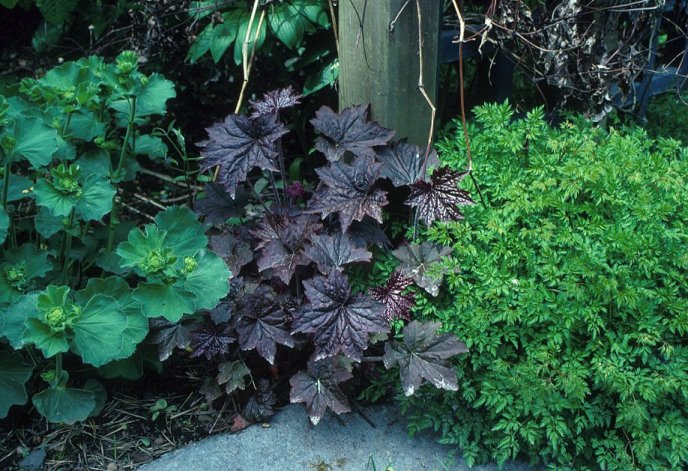| Botanical Name: Heuchera micrantha 'Palace Purple' | |
| Common Name: Palace Purple Coral Bells |

-
Anatomy
-
Culture
-
Design
Plant Type
Perennial
Height Range
1-3'
Flower Color
White
Flower Season
Summer
Leaf Color
Bronze, Brown, Dark Green, Purple
Bark Color
n/a
Fruit Color
n/a
Fruit Season
n/a
Sun
Half, Shade
Water
Medium
Growth Rate
Moderate
Soil Type
Sandy, Clay, Loam
Soil Condition
Average, Rich, Well-drained
Soil pH
Neutral
Adverse Factors
n/a
Design Styles
English Cottage, Japanese, Woodland
Accenting Features
Showy Flowers
Seasonal Interest
Summer, Fall
Location Uses
Perennial Border
Special Uses
Container, Small Spaces
Attracts Wildlife
n/a
Information by: Stephanie Duer
Photographer: Linda Engstrom
Photographer: Linda Engstrom
-
Description
-
Notes
'Palace Purple' was one of the the first red-leafed coral bells introduced. It is variable in height and color (source is key), they generally have purple to bronze to dark green foliage that is sharply lobed, and they grow about 18 to 20 inches tall and wide. Flowers are white and bloom early spring. While it tolerates shade, leaf color is best with some sun. Some plants are seed-source, and so leaf-color varies.
Grow in well drained soil in full sun to light shade (depending on the variety). When planted in full sun, they do best when not situated where it is very hot, such as against walls or by sidewalks. Ideally, plant in loamy soils, in dry shade to part shade conditions. Remove entire stalk after flowering to encourage continued bloom. In our cold winters, Heuchera crowns can heave above the soil line. Mulching after the ground freezes hard, will prevent the freezing and thawing that pushes the plants up. Check periodically to make sure the roots are not exposed. Replant, if possible. Some varieties are listed as evergreen; in our climate, it depends on the variety, the winter, and where they are planted. But even if not evergreen, the foliage carries well into the fall and early winter months. They do not do well in damp soils.